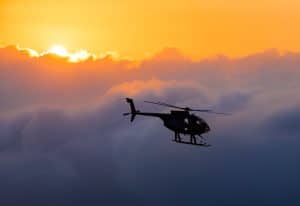Hawaii Helicopter Crash is a Reminder of How Dangerous This Touring Industry Can Be
 The crash of a Bell 407 helicopter carrying five passengers on June 8, 2022, on the Big Island is a reminder that the Hawaii helicopter tour industry continues to be responsible for deaths and injuries associated with commercial helicopter sightseeing flights. The most recent crash occurred on a flight operated by K&S Helicopters which does business as Paradise Helicopters.
The crash of a Bell 407 helicopter carrying five passengers on June 8, 2022, on the Big Island is a reminder that the Hawaii helicopter tour industry continues to be responsible for deaths and injuries associated with commercial helicopter sightseeing flights. The most recent crash occurred on a flight operated by K&S Helicopters which does business as Paradise Helicopters.
Aviation attorney Ladd Sanger, who recently settled a case against Blue Hawaiian Helicopters with Hawaii attorney Rick Fried, stated, “Every one of the Hawaii air tour helicopter crashes we have handled have been preventable. Each one involved safety deficiencies in the pilot and operator of the helicopter or experienced malfunctions due to deficiencies in maintenance or manufacturer design.”
“These helicopters and pilots are pushed to their limits by the Hawaii operators and sometimes beyond,” added Sanger, explaining that “high utilization of helicopters, or many hours of flying time each day demands meticulous maintenance processes and adequate rest for the pilots. Malfunctions and mistakes, often fatal, result from such high utilization.”
Fried, whose Honolulu firm has handled several aviation accidents with the Texas-based law firm of Slack Davis Sanger, stated, “We continue to see helicopter air tour operators crashing. Every one of these accidents is a black eye on Hawaii tourism and suggests that the Hawaii air tour industry is putting profits ahead of safety.”
The firms have handled and successfully resolved multiple air tour helicopter crash cases together, including another case involving K&S, which was a McDonnell Douglas helicopter that crashed in Hauula, Hawaii in 2019, injuring 4 passengers. The firms also handled a fatal Blue Hawaiian air tour accident on Molokai in 2011 and an air tour accident that occurred in 2016 on Kauai that seriously injured all passengers.
Fried notes that while the Federal Aviation Administration (FAA) has regulatory oversight of the air tour industry, it has not been sufficiently proactive in addressing safety issues in Hawaii and in other states like Alaska. “The FAA is not doing its job and using its authority to punish lax operators. The public trust in the FAA is, unfortunately, misplaced as the world witnessed with the Boeing Max 8 debacle. Our tourists and Hawaii residents deserve better from the regulator of aviation safety.”
Sanger, also a licensed helicopter pilot, adds “attempts by segments of the aviation industry to self- regulate for safety purposes have never succeeded. Two notable examples are the pathetic safety records of the air tour industry and the air ambulance industry. Pressure from the FAA is an imperative to changing pilot, operator, maintainer, and manufacturer behaviors.”
Sanger noted that the Bell 407 model initially had safety issues, but its safety record had improved in recent years. Photographs published by media do not show the helicopter’s tail boom which appears to have separated from the primary cabin wreckage. Exactly why and when the tail boom separated, is not known but will be addressed by investigators from the National Transportation Safety Board (NTSB). The NTSB will also be studying the weather conditions in which the helicopter was flying. From handling other air tour cases in Hawaii, Fried and Sanger emphasize that weather conditions change significantly with time and location across the islands. Often the pilots are not properly trained and sufficiently experienced in the diverse Hawaii weather environment to operate safely. As with the 2016 fatal crash on Molokai, strong downdrafts on the leeward side of an island can literally drive a helicopter into the ground from what a pilot may assume is a safe altitude.
Since becoming involved in air tour and air ambulance accidents over the last 30 years, Sanger and his partner, Mike Slack, have advocated the use of twin turbine engine helicopters to enhance safety to passengers. The two engines offer higher reliability of power to the rotors and more performance capability when operating with high passenger loads.
Since 1993, Slack Davis Sanger has been serving clients nationally and internationally, with a combined experience of more than 250 years. Slack Davis Sanger has extensive experience in litigation involving aircraft crashes. For more information, please contact Rhett Whiting at Slack Davis Sanger at 512-225-5315 or rwhiting@slackdavis.com.

The firm handles cases involving catastrophic personal injuries and deaths. Our work spans three decades of handling airplane and helicopter crashes, truck and car accidents, oilfield and construction accidents, and other devastating accidents. We try lawsuits throughout the country in both federal and state courts and have recovered hundreds of millions of dollars for our clients. To date, we have handled or tried cases in 47 states, read more about our attorneys and firm.
